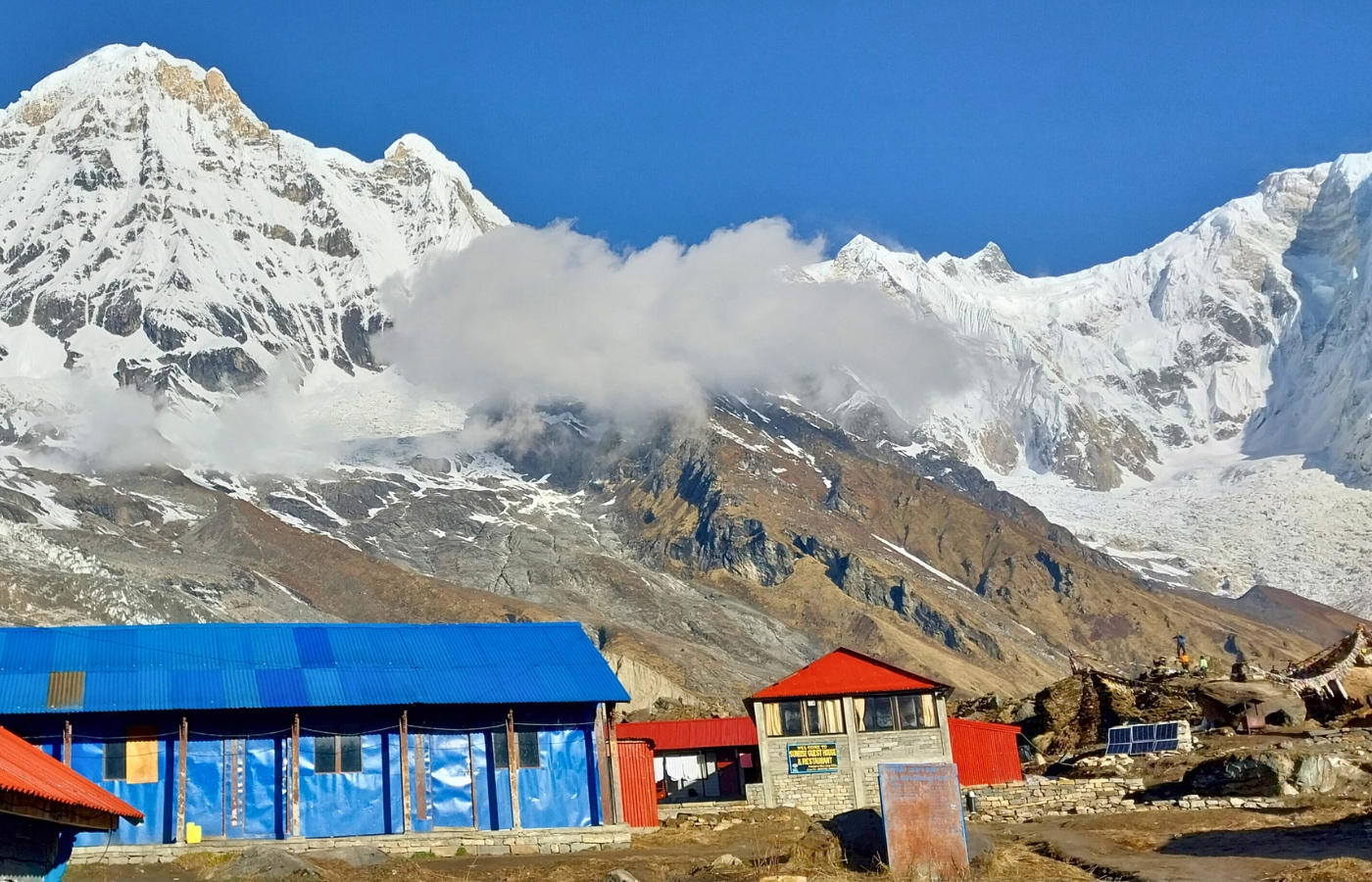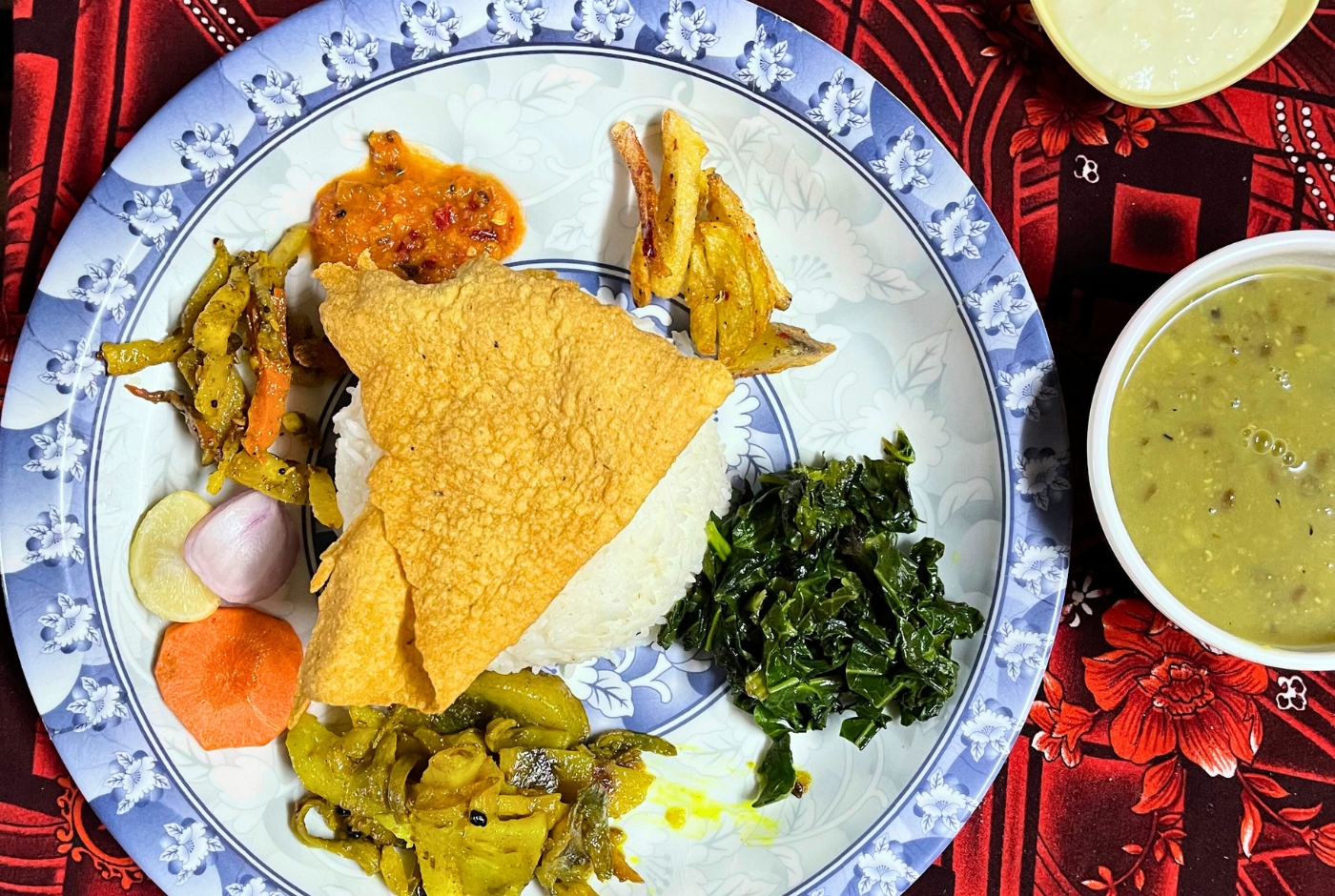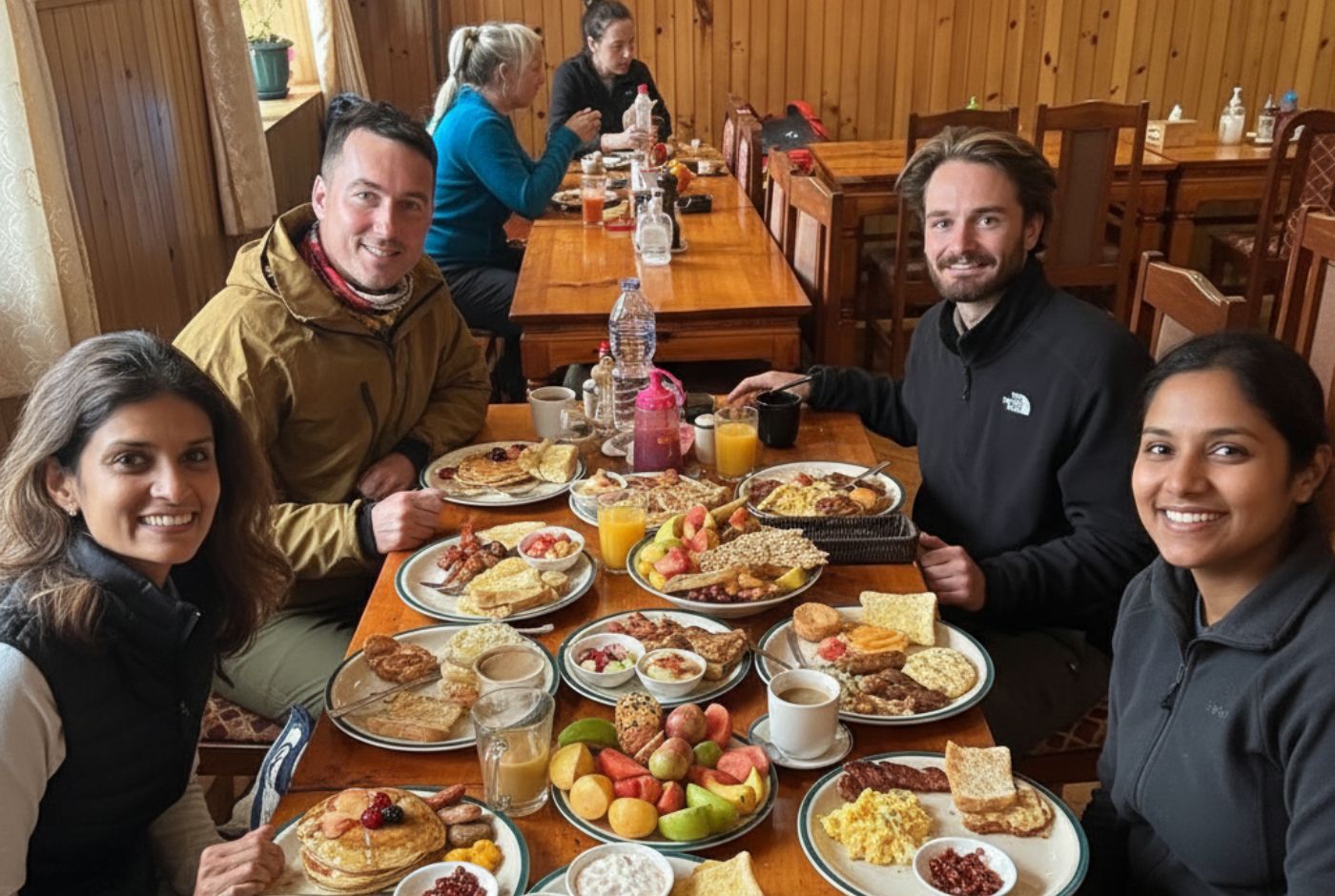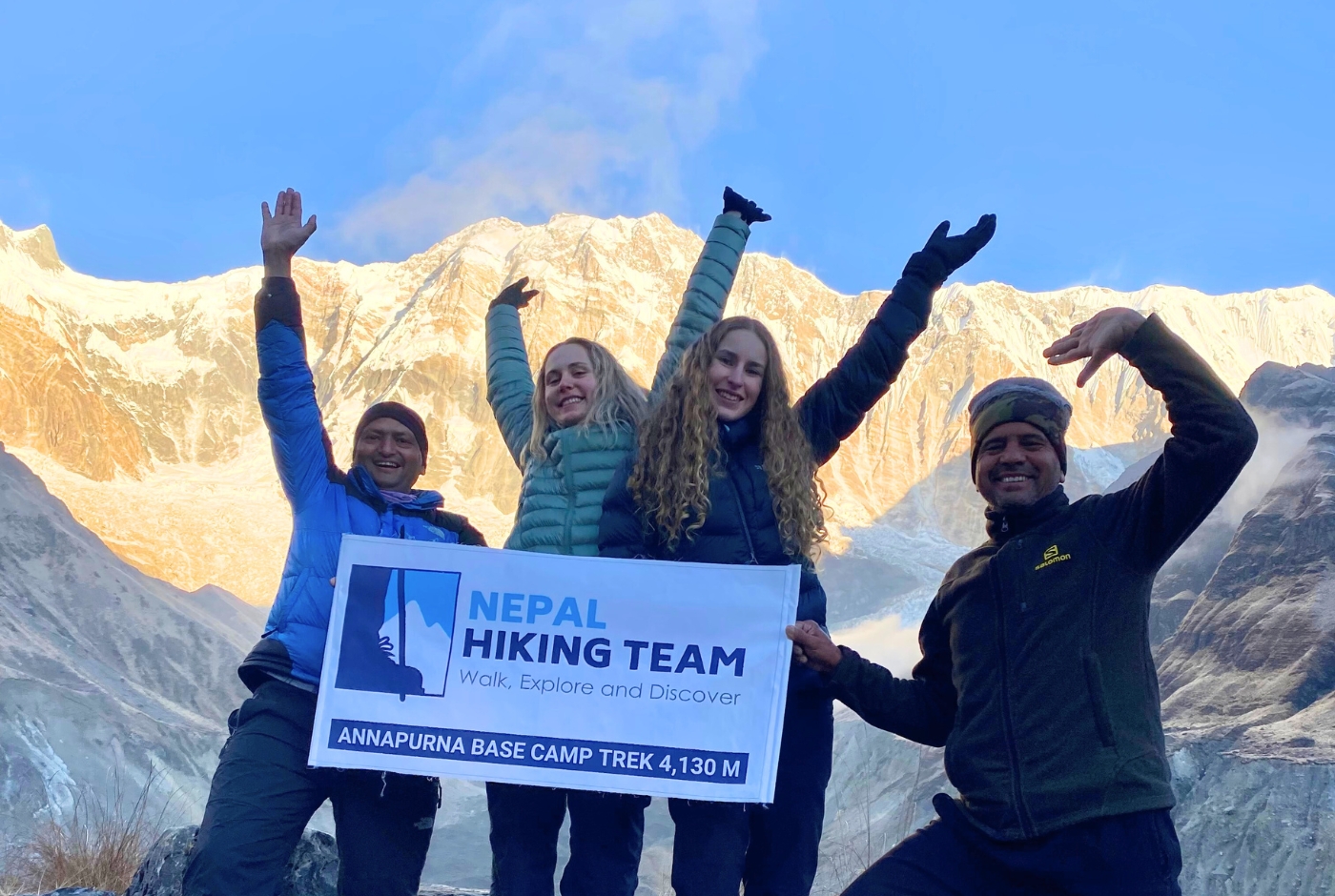- Diverse Food Options in ABC trek:
- Food choices and prices change with Elevation
- How Altitude Affects Appetite and Eating
- Meat Restrictions in the Annapurna Sanctuary
- The Best Dish on the Annapurna Trek
- Food hygiene in the Annapurna Base Camp trek
- Availability of light snacks:
- Carrying extra snacks and dry fruits
- Clean water in the Annapurna Base Camp Trek
- Tips for food in the Annapurna Base Camp trek
Authentic food and safe drinking water are the fundamental aspects of the Annapurna Base Camp. The trek includes trails far from the urban centres of Nepal, so you must be mentally prepared for completely new eating patterns and local cuisines.
Today, we will delve deep into the fooding preferences, options and suggestions, plus clean water availability during the Annapurna Base Camp Trek.
Genuine, typical and local Nepali meals during your journey add texture to your Annapurna Base Camp trekking experience.
It is safe to mention that only healthy food and clean water fuel your trip to ABC, and any wrong choice for the selection of food can have adverse effects on your health and hamper the entire trekking pursuit.
Therefore, you should be very cautious when exploring the meal and cuisine options and the modes of water consumption available to you while planning your trek to Annapurna Base Camp.
Here are essential details we will discuss about food and water during the Annapurna Base Camp Trek:
Diverse Food Options in ABC trek:

All the teahouses along the Annapurna Base Camp offer the trekker a choice of Western, Tibetan and Nepalese dishes.
Here, we have prepared a list of general food items available during the Annapurna Base Camp trek.
Breakfast
The Annapurna Base Camp Trek offers a variety of breakfast options, including porridge, toast with jam, eggs, pancakes, chapati, muesli, fried potatoes, omelette, rice pudding, cornflakes, and seasonal fruits.
- Porridge: Porridge is a warm and enjoyable breakfast that is often served with honey, sugar, and fruits
- Tibetan bread: Trekkers' favourite, Tibetan Bread can be munched with jam or butter.
- Toast with Jam: Simple and popular, Toast with jam/better is a light breakfast preference during the Annapurna Trek
- Eggs: Eggs are simple but packed with protein. It serves to be essential in the high elevation of the Annapurna Base Camp trek. Scrambled, boiled, or fried eggs are common in these areas.
- Pancakes: Pancakes served with honey, butter or jam are accessible throughout the Camp trek.
- Chapati: Also referred to as Roti, Chapati is a traditional flatbread served with lentils (dal) or curry (tarkari).
- Muesli: Muesli is a healthy mix of oats, nuts, and fruits, served with yogurt in the ABC Trek.
- Fried Potatoes: Fried potatoes in the lap of the mountains are favourites in Annapurna.
- Omelette: Omelette is a classic choice for the Annpurna Base Camp trek and is often prepared with available veggies.
- Rice Pudding: Rice pudding is a Nepali-style porridge which contains the sweet texture of milk, rice and dry fruits
- Cornflakes: Cornflakes are a light breakfast option often served in milk or yogurt during the Annapurna base Camp Trek.
- Seasonal Fruits: Depending on the season, fruits like apples and bananas can be available in the Annapurna Highlands.
Annapurna Base Camp Trek Food Menu

Lunch
- Dal Bhat: Dal Bhat is a traditional Nepali meal consisting of lentils, rice, vegetables, and sometimes chicken or meat (available until Chhomrong). Dal Bhat is accessible in any part of the Annapurna Base Camp Trek. More traditional and authentic Dal Bhat can be enjoyed in Kathmandu and Pokhara itself.
- Noodles: Noodles are made with veggies, a warm breakfast option
- Momos: Momos are an all-time classic Nepali dumpling, filled with vegetables and meat (until Chhomrong).
- Vegetable Thukpa: Thukpa is the Nepali twist of Chowwmein and is often served with any available toppings in the lodges.
- Macaroni: Also referred to as pasta, Macaroni is a comfort food in the highlands of Nepal.
- Pizza: Pizza is a Western comfort food enjoyed by all trekkers in the trek.
- Spaghetti: Spaghetti is packed with cheese richness and comes with a burst of flavour.
- Sandwiches: Sandwiches are usually filled with cheese, cucumber, tomato, and even eggs.
- Fried Rice: Fried Rice is a stir-fried breakfast option
- Vegetable Soup: Vegetable soup is a warm and light soup, ideal for a midday break.
- French Fries: French fries are a simple snack option, often served with ketchup in the lower altitudes of the Annapurna Base Camp Trek
Snacks
- Chips and Biscuits: Packaged snacks are readily available in most teahouses, making them a convenient and quick snack option.
- Granola Bars: Multiprotein bars are great for a quick energy boost on the trail.
- Fruits: Dried or fresh fruits can be bought in most guesthouses
- Chocolate: Chocolate is a popular energy snack, helpful in providing a boost of energy
Dinner
- Dal Bhat: Again, at this meal, Dal Bhat is served with variations in vegetables or meat (unavailable after Chommrong).
- Vegetable Curry: Curry of simple vegetables with rice or chapati can give you warmth
- Thukpa: A warm Thukpa with vegetables for dinner keeps the night warm
Extras
- Samosas: Samosas are Indian-origin fried pastries filled with vegetables
- Fried Chicken: Classic fried Chicken is sometimes available in teahouses at lower altitudes (until Chommrong).
- Cookies: Cookies are simple, sweet snacks often found in most teahouses in the Annapurna Base Camp trek
- Chips: Chips are a typical packaged snack, sometimes available at lower altitudes.
- Biscuits: Biscuits are packed with varied flavours commonly available at teahouses for a light snack.
Drinks
- Tea: Tea is a warm break or any meal; Masala chai (spiced tea), black tea, lemon tea, green tea, and ginger tea with honey and many more options are available throughout the trek in the Annapurna Base Camp trek
- Coffee: Coffee in Annpurna Base Camp Trek is either instant coffee or locally brewed. Consumption of intense caffeine can have adverse effects on acclimatisation in the Annapurna Base Camp Trek.
- Hot Lemon: Hot Lemon is an alternative to Tea or coffee, made with hot water, lemon, and sugar, and is claimed to be good for hydration.
- Hot Chocolate: Hot Chocolate provides a sweetening warmth during the trek.
- Hard Drinks: Local beers and available Hard drinks in guesthouses and lodges can be enjoyed throughout the trek in Annapurna. Consumption of intense Hard Drinks can have adverse effects on acclimatisation in the Annapurna Base Camp Trek.
Desserts
- Chocolate Pudding: Chocolate pudding is sweet and rich in flavour, an excellent dessert to treat yourself to during the Annapurna Base Camp Trek.
- Apple Pie: Apple Pie is a popular dessert option in the lower elevations of the Annapurna Base Camp trek
- Cakes: Basic and simple cakes are usually available upto Chommrong.
Food options can be limited and vary by teahouse, especially as you ascend higher on the trek, but you'll still find hearty, nutritious meals to keep you energised for the day.
Food choices and prices change with Elevation

International culinary practices and delicacy options are prominent in urban centres like Kathmandu and Pokhara.
Small settlements of the lower trail of the ABC trek, like Birethanti(starting point of Annapurna Base Camp Trekking), Hile, Ulleri, and Chuile, offer basic food options somewhere between urban variety and highland simplicity.
Ghorepani, a traditional Gurung village located between Chuile and Ulleri, is a popular stop for both domestic and international trekkers. This destination provides one of the best tastes of typical Nepali cuisine you can find in the entire ABC trek.
On your return from ABC, Jhinu Danda offers reliable food supplies and supplements, thanks to its easy access from Pokhara.
Lodges situated in the higher elevation villages generally feature comparable food options, yet the food portions, food taste, preparation hygiene, food practices and price are much variable. As altitude increases, the prices start to surge gradually.
Chommrong (2,170m) is the last reliable stop before Annapurna Sanctuary, where you can get to consume non-veg delicacies (chicken, mutton and buff). You can still find bakery items (cupcakes, cakes, bread) and fresh veggies. From Chommrong onwards, the food portions start to shrink.
In Bamboo (2,310m), the menus remain simple but still varied. Rice, noodles, and potatoes dominate the menu.
During your stay in Deurali (3,200m), the menus come with fewer vegetables and less variety. Packed snacks may be available, but at high-marked-up prices.
Annapurna Base Camp (4,130m) marks the highest altitude and the highest fooding menu in your ABC trek. Warm ginger tea is available to combat altitude sickness. No meat and no fresh vegetables are found in the menu, and the menu is dominated by carbohydrates, mainly to fuel the trekkers for the journey.
How Altitude Affects Appetite and Eating
One of the disturbing experiences that entry-level trekkers face during the Annapurna Trek is the loss of appetite after the elevation of 3,500m. The symptoms typically begin to appear around Deurali (3,200m) and become more noticeable on the way to Machhapuchhre Base Camp (3,700m).
Loss of Appetite is usually seen as an early sign of Altitude sickness. Loss of appetite can easily cause fatigue and exhaustion.
Loss of Appetite accompanied by vomiting and nausea signals higher degrees of Altitude sickness. We must act immediately in such cases. If medications such as Diamox (included in the first aid kit), eating hot soups and porridges, and maintaining sufficient hydration do not work, then we have to initiate an immediate descent, usually to dropping our elevation to below 3500m to Deurali, Dovan, Bamboo or even to Chommrong, as prescribed by your accompanying guide..
To prevent these extremities, we should take precautions by prioritising enough acclimatisation time and steadily pacing ourselves in the Annapurna trek.
Meat Restrictions in the Annapurna Sanctuary
Annapurna Base Camp (4,130m) is considered a spiritual site by local Gurung and Magar communities. It is believed to be the home of Buddhist and Hindu deities. Hence, consumption of meat items is restricted in the Annapurna Sanctuary region.
Lodges of landmarks after Chommrong, at Sinuwa, Dovan, Deurali, MBC and ABC do not prepare meat dishes.
This is highly beneficial to the trekkers. This is because at high altitude, oxygen level decreases and coldness steeply rises, resulting in delayed metabolism and slow digestion. Indigestion can easily cause fatigue and exhaustion.
The Best Dish on the Annapurna Trek

Dal Bhat is power - 24 hours!!!
Dal bhat is typical and local Nepali food, which is very common throughout the trek to ABC. This is due to its multi-nutritional value, unique Nepali taste, and easy preparation of the dish.
Bhat (Steamed White Rice)
Composition: The primary carbohydrate source, typically white rice, is steamed until soft and fluffy. It serves as the base of the meal.
Varieties: Sometimes, brown rice may be offered for a healthier alternative, though white rice is more commonly served in the Annapurna Base Camp Trek.
Dal (Lentils)
Composition: The dal, or lentils, are boiled and then cooked into a soup-like consistency with turmeric, cumin, garlic, and ginger for flavour. Lentils are the protein-rich component of the dish.
Varieties: The most common types of dal used are masoor dal (red lentils), toor dal (yellow split peas), or moong dal (green gram). The seasoning and thickness of dal may vary depending on the region and personal preferences.
Tarkari (Curried Vegetables)
Composition: A mixed vegetable curry, often made with seasonal vegetables like potatoes, carrots, cauliflower, peas, and green beans. It is usually seasoned with turmeric, cumin, coriander, and other spices.
Variations: The vegetables change depending on the availability at different elevations. For example, in the lower-altitude areas of Annapurna Base Camp, the vegetables include a broader variety, while at higher elevations, they are more basic.
Takari is made spicy or plain, depending on the seasoning used in the guesthouses.
Saag (Cooked Leafy Greens)
Composition: Saag refers to cooked leafy greens, typically spinach, mustard greens, or locally available wild greens. They are sautéed with garlic, ginger, and sometimes onions to enhance flavour.
Health Benefits: These greens provide essential vitamins and minerals like iron and calcium, which are especially beneficial for trekkers in Annapurna Base Camp.
Achar (Pickles)
Composition: Achar is a tangy and spicy pickle made from various ingredients like tomatoes, radishes, cucumbers, or even fermented vegetables. It adds a sharp, spicy contrast to the otherwise mild flavours of dal bhat.
Varieties: The achar may be made with mustard oil, chilli, and other spices, and it can either be fresh or fermented.
Regional Variation: In some regions, achar may also be made from local fruits, such as fermented mango or wild herbs, providing unique flavours.
Variation and changes in the Annapurna Base Camp trek:
Portion Size: Portions may be slightly smaller at higher elevations due to limited supplies, but dal bhat is usually generous enough to keep trekkers full and energised.
Quality and Taste: The base remains the same, yet flavour and variety shift with altitude. In Kathmandu or Pokhara, meals are richer with more vegetables, while in the higher up, they become simpler with fewer ingredients.
Meat Options: Some teahouses serve chicken or goat dal bhat for added protein, but in the Annapurna Sanctuary, especially after crossing Chommron, vegetarian versions dominate because fresh meat is difficult to source.
Thakali Dal Bhat is renowned in urban cities like Kathmandu and Pokhara.
Being flexible and having good proportions of carbohydrates, proteins, and fat, Dal Bhat is the unique taste of the Annpurna Base Camp Trek.
Food hygiene in the Annapurna Base Camp trek
Food hygiene is one of the most fundamental aspects when it comes to fooding practices in ABC trek. Experienced guides have prior knowledge and notes on good lodges that provide quality hygiene at each trekking stop.
Unhygienic food can primarily cause:
- Diarrhea
- Dehydration
- Weakness
- Nausea
- Food poisoning
- Stomach infections
These conditions can remain critical at high altitudes, such as during the Annapurna Base Camp trek.
Hence, to prevent these cases, hand-picked guesthouses and lodges should be selected for a smooth trek into the sanctuary.

Availability of light snacks:
Light snacks like biscuits, Cup noodles, and chips are easily accessible in Kathmandu and Pokhara at their standard prices. But in the lower and higher trial of the Annapurna Base Camp trek, they have a high-marked-up price, if they are available. And the price increases with the increase in elevation. This is due to the limited transportation accessibility in the highlands.
Carrying extra snacks and dry fruits
Carrying extra snacks, such as dehydrated fruits like nuts, and an energy bar, is a wise option for many good reasons. First, they are lightweight and can be packed in small pouches. This remains crucial for the Annapurna Base Camp Trek because a porter can carry a maximum of 25 kg, which is the bag weight limit for two people. Also, during the trek, in case of loss of appetite, you can consume your snack. Snacks are also available in some guest houses, but are marked up at high prices.
Clean water in the Annapurna Base Camp Trek
Clean water is a necessity for any smooth trekking experience, but in the Annapurna region, accessing it can be tricky.
At the higher elevations, the cost of warm water increases sharply in the guesthouses and lodges.
Above 2800m, especially from Chommrong, the glass of hot water starts to cost anywhere between 100 and 200 NPR, while a 1L bottle costs about 400NPR. These are rough values and fluctuate depending on the time of year, elevation, weather conditions, and many other factors.
For cold water, you can find tap water along the trail or purchase water at guesthouses. However, it's important to note that plastic bottles are strictly prohibited on the Annapurna Base Camp Trek.
While drinking water directly from streams or taps is not recommended, it can be safely purified using:
IODINE TABLETS:
Iodine tablets are a compact, effective way to purify water, killing harmful microbes. Popular brands used by trekkers in the Annapurna Base Camp Trek include Potable Aqua, Polar Pure, and Coghlan's, which ensure safe drinking water after 30 minutes to an hour.
Here is how to use them:
- Step 1: Fill your reusable container with water from the tap or a natural hot spring
- Step 2: Add 1 iodine tablet per litre
- Step 3: Stir and wait for 30 minutes to an hour before drinking.
LIFE STRAW WATER FILTER:
The Lifestraw Water Filter is a compact, efficient tool that filters out bacteria, parasites, and debris. By sucking water directly through the straw it provides immediate access to purified water.
Here is how to use them:
- Step 1: Place the filter end of the Lifestraw into the water source.
- Step 2: Suck water through the straw to filter and drink directly.
Piyush Water Treatment Drops
Piyush Water Treatment Drops are a simple and effective solution for purifying water.
- Step 1: Fill your water container
- Step 2: Add the recommended 1- 2 drops of Piyush Water Treatment Drops in about 1 litre of water
- Step 3: Stir the solution and wait for 30 minutes before drinking.
It’s recommended to use electrolytes to help prevent dehydration during the Annapurna Base Camp trek.
Tips for food in the Annapurna Base Camp trek
- Hydration is key: Drink plenty of water throughout the day. Average walking hours are 5 - 7 hours each day. Only water may not be enough for all the trekkers. So, consider adding electrolyte tablets to keep you hydrated enough.
- Small and Frequent Meals are efficient: Instead of large meals, eat small, frequent snacks to maintain energy levels and aid digestion. Hedge eating can easily cause dizziness and fatigue.
- High-Calorie, Nutrient-Dense Foods matter: Focus on foods that provide sustained energy and quality, which are packed with nutrients, such as Dal Bhat. If possible, avoid bad cholesterol, fatty foods and carbonated drinks.
- Local Specialties: Dal Bhat is a phenomenal dish that provides a balanced diet with essential nutrients. Yet, you can, of course, try other local dishes to experience the regional cuisine.
- Food Safety: Avoid raw vegetables, salads, and unpeeled fruits to minimise the risk of foodborne illness.
- Meat Considerations: Meat items are strictly restricted after you reach Sinuwa due to local tradition concerns. Meat at Chommrong and below, if available, might not continually be refrigerated and may not be fresh, so it's wise and highly recommended to avoid it.
- Limit Alcohol and Caffeine: These can contribute to dehydration and affect acclimatisation.
Conclusion from the Nepal Hiking Team

At Nepal Hiking Team, we are a fully authorised, local travel agency committed to enhancing your trekking in Nepal. We provide expert recommendations on food and water, ensuring your health and comfort throughout the journey. Our team carefully selects guesthouses and lodges with the best hospitality, a friendly atmosphere, and top-notch hygiene standards, prioritising your well-being and safety.
We offer a 14-day Annapurna Base Camp Trek, and we would be delighted to guide you through this unforgettable adventure in the Annapurna region. We look forward to welcoming you to Nepal!



